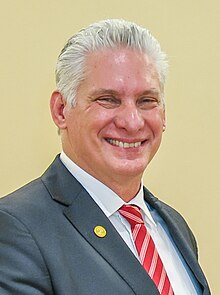This article needs additional citations for verification. (April 2020) |
| President of the Republic of Cuba | |
|---|---|
| Presidente de la República de Cuba | |
 | |
 Presidential standard | |
since 10 October 2019 | |
| Presidential Office of Cuba Executive branch of the Government of Cuba | |
| Style | Mr President (informal) His Excellency (diplomatic) |
| Type | Head of state |
| Member of | National Assembly of People's Power |
| Reports to | Council of State |
| Residence | Palacio de la Revolución |
| Nominator | National Assembly of People's Power |
| Appointer | National Assembly of People's Power |
| Term length | Five years, renewable once[1] |
| Constituting instrument | Constitution of 2019 |
| Precursor | President of the Council of State |
| Formation | 12 April 1902 |
| First holder | Tomás Estrada Palma |
| Abolished | December 1976–October 2019 |
| Deputy | Vice President |
| Website | Official website |
 |
|---|
|
|
The president of Cuba (Spanish: Presidente de Cuba), officially the president of the Republic of Cuba (Spanish: Presidente de la República de Cuba), is the head of state of Cuba. The office in its current form was established under the Constitution of 2019. The President is the second-highest office in Cuba and the highest state office. Miguel Díaz-Canel became President of the Council of State on 19 April 2018, taking over from Raúl Castro, and has been President of Cuba since 10 October 2019.
The First Secretary of the Communist Party of Cuba continues to be the highest-ranking political position in Cuba. Fidel Castro held the position from 1976 to 2011, and Raúl Castro from 2011 until the 8th Congress of the Communist Party of Cuba, held 16–19 April 2021, when he retired from office.[2]
- ^ "Raul Castro says Cuba needs term limits for its leaders". Archived from the original on 2018-03-28. Retrieved 2016-09-07.
- ^ "Raul Castro passes power in Cuba to younger generation of communists". Globe and Mail. Reuters. April 16, 2021. Retrieved April 16, 2021.
